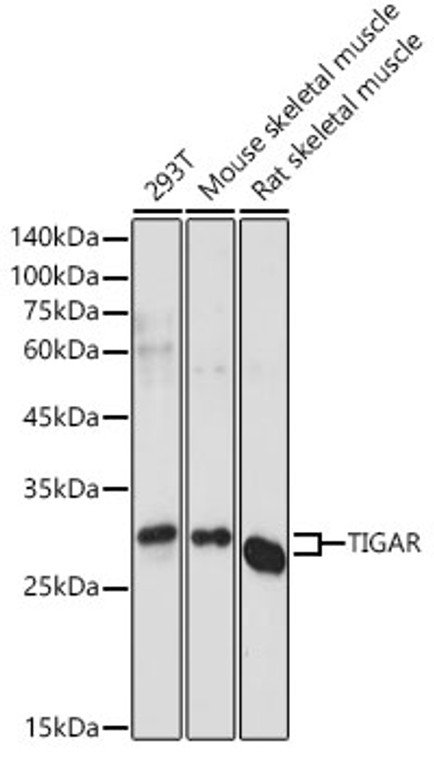| Host: |
Rabbit |
| Applications: |
WB/IF |
| Reactivity: |
Human/Mouse/Rat |
| Note: |
STRICTLY FOR FURTHER SCIENTIFIC RESEARCH USE ONLY (RUO). MUST NOT TO BE USED IN DIAGNOSTIC OR THERAPEUTIC APPLICATIONS. |
| Short Description: |
Rabbit polyclonal antibody anti-TIGAR (100-200) is suitable for use in Western Blot and Immunofluorescence research applications. |
| Clonality: |
Polyclonal |
| Conjugation: |
Unconjugated |
| Isotype: |
IgG |
| Formulation: |
PBS with 0.05% Proclin300, 50% Glycerol, pH7.3. |
| Purification: |
Affinity purification |
| Dilution Range: |
WB 1:500-1:1000IF/ICC 1:50-1:200 |
| Storage Instruction: |
Store at-20°C for up to 1 year from the date of receipt, and avoid repeat freeze-thaw cycles. |
| Gene Symbol: |
TIGAR |
| Gene ID: |
57103 |
| Uniprot ID: |
TIGAR_HUMAN |
| Immunogen Region: |
100-200 |
| Immunogen: |
A synthetic peptide corresponding to a sequence within amino acids 100-200 of human TIGAR (NP_065108.1). |
| Immunogen Sequence: |
LSELRAMAKAAREECPVFTP PGGETLDQVKMRGIDFFEFL CQLILKEADQKEQFSQGSPS NCLETSLAEIFPLGKNHSSK VNSDSGIPGLAASVLVVSHG A |
| Tissue Specificity | Expressed in the brain. Expressed in breast tumors. Expressed in glioblastomas. |
| Function | Fructose-bisphosphatase hydrolyzing fructose-2,6-bisphosphate as well as fructose-1,6-bisphosphate. Acts as a negative regulator of glycolysis by lowering intracellular levels of fructose-2,6-bisphosphate in a p53/TP53-dependent manner, resulting in the pentose phosphate pathway (PPP) activation and NADPH production. Contributes to the generation of reduced glutathione to cause a decrease in intracellular reactive oxygen species (ROS) content, correlating with its ability to protect cells from oxidative or metabolic stress-induced cell death. Plays a role in promoting protection against cell death during hypoxia by decreasing mitochondria ROS levels in a HK2-dependent manner through a mechanism that is independent of its fructose-bisphosphatase activity. In response to cardiac damage stress, mediates p53-induced inhibition of myocyte mitophagy through ROS levels reduction and the subsequent inactivation of BNIP3. Reduced mitophagy results in an enhanced apoptotic myocyte cell death, and exacerbates cardiac damage. Plays a role in adult intestinal regeneration.contributes to the growth, proliferation and survival of intestinal crypts following tissue ablation. Plays a neuroprotective role against ischemic brain damage by enhancing PPP flux and preserving mitochondria functions. Protects glioma cells from hypoxia- and ROS-induced cell death by inhibiting glycolysis and activating mitochondrial energy metabolism and oxygen consumption in a TKTL1-dependent and p53/TP53-independent manner. Plays a role in cancer cell survival by promoting DNA repair through activating PPP flux in a CDK5-ATM-dependent signaling pathway during hypoxia and/or genome stress-induced DNA damage responses. Involved in intestinal tumor progression. |
| Protein Name | Fructose-2 -6-Bisphosphatase TigarTp53-Induced Glycolysis And Apoptosis RegulatorTp53-Induced Glycolysis Regulatory Phosphatase |
| Database Links | Reactome: R-HSA-5628897 |
| Cellular Localisation | CytoplasmNucleusMitochondrionTranslocated To The Mitochondria During Hypoxia In A Hif1a-Dependent MannerColocalizes With Hk2 In The Mitochondria During HypoxiaTranslocated To The Nucleus During Hypoxia And/Or Genome Stress-Induced Dna Damage Responses In Cancer CellsTranslocation To The Mitochondria Is Enhanced In Ischemic Cortex After Reperfusion And/Or During Oxygen And Glucose Deprivation (Ogd)/Reoxygenation Insult In Primary Neurons |
| Alternative Antibody Names | Anti-Fructose-2 -6-Bisphosphatase Tigar antibodyAnti-Tp53-Induced Glycolysis And Apoptosis Regulator antibodyAnti-Tp53-Induced Glycolysis Regulatory Phosphatase antibodyAnti-TIGAR antibodyAnti-C12orf5 antibody |
Information sourced from Uniprot.org
12 months for antibodies. 6 months for ELISA Kits. Please see website T&Cs for further guidance









